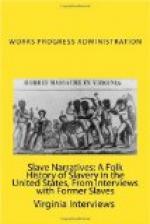“There were about this time a number of white people who had been going through Cockeysville, some trying to find out if there was any concerted move on the part of the slaves to run away, others contacting the free people to find out to what extent they had ‘grape-vine’ news of the action of the Negroes. The Negro who was seen coming from mother’s home ran away. She was immediately accused of Voodooism by the whites of Cockeysville, she was taken to Towson jail, there confined and grilled by the sheriff of Baltimore County—the Cockeys, and several other men, all demanding that she tell where the escaped slave was. She knowing that the only way he could have escaped was by the York Road, north or south, the Northern Central Railroad or by the way of Deer Creek, a small creek east of Cockeysville. Both the York Road and the railroad were being watched, she logically thought that the only place was Deer Creek, so she told the sheriff to search Deer Creek. By accident he was found about eight miles up Deer Creek in a swamp with several other colored men who had run away.
“Mother was ordered to leave Baltimore County or to be sold into slavery. She went to York, Pennsylvania, where she stayed until 1865, when she returned to her home in Cockeysville; where a great many of her descendants live, now, on a hill that slopes west to Cockeysville Station, and is known as Foote’s Hill by both white and colored people of Baltimore County today.
“I was born in Cockeysville in 1867, where I have lived since; reared a family of five children, three boys and two girls. I am a member of the A.M.E. Church at Cockeysville. I am a member of the Masonic Lodge and belong to Odd Fellows at Towson, Maryland. The Foote’s descendants still own five or more homes at Cockeysville, and we are known from one end of the county to the other.”
Maryland
Sept. 22, 1937
Rogers
Menellis Gassaway, Ex-slave.
Reference: Personal interview with Menellis Gassaway,
ex-slave,
on
Sept. 22, 1937, at M.E. Home, Carrollton Ave.,
Baltimore.
“My name is Menellis Gassaway, son of Owing and Annabel Gassaway. I was born in Freedom District, Carroll County, about 1850 or 52, brother of Henrietta, Menila and Villa. Our father and mother lived in Carroll County near Eldersberg in a stone and log cabin, consisting of two rooms, one up and one down, with four windows, two in each room, on a small farm situated on a public road, I don’t know the name.
“My father worked on a small farm with no other slaves, but our family. We raised on the farm vegetables and grain, consisting of corn and wheat. Our farm produced wheat and corn, which was taken to the grist mill to be ground; besides, we raised hogs and a small number of other stock for food.
“During the time I was a slave and the short time it was, I can’t remember what we wore or very much about local conditions. The people, that is the white people, were friendly with our family and other colored people so far as I can recall.




